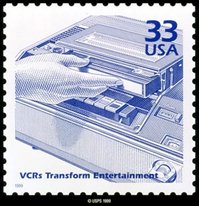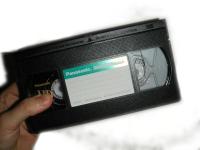The videocassette recorder (or VCR, more commonly known in the British Isles as the video recorder), is a type of video tape recorder that uses removable videotape cassette containing magnetic tape to record audio and video from a television broadcast so it can be played back later. Many VCRs have their own tuner (for direct TV reception) and a programmable timer (for unattended recording of a certain channel at a particular time).
Later model VCRs can record and play tapes both in Standard Play (SP) format and in Long Play (LP) format. LP format increases the available recording time, at the loss of some video and sound quality. Some can even record and play in the Extra Long Play (EP, ELP, or SLP) format, which slows down the tape speed to about one third of SP; however, this causes even greater loss of sound and video quality. Extra long play was mainly aimed at the American market, where the general public seemed less concerned with playback quality.
History
Early machines and formats
The history of the videocassette recorder follows the history of videotape recording in general. Ampex introduced the first commercially successful videotape recorder in 1956. It was referred to as the 2" Quadruplex format, using two-inch (5.1 cm) tape. Due to its US$50,000 price, 2" Quadruplex could be afforded only by the television networks and the largest individual stations. Sony marketed in 1963 the first reel-to-reel VTR intended for business, medical, airline, and educational use. The Sony model CV-2000 in 1964 was the world's first VTR intended for home use. Ampex and RCA followed in 1965 with their own reel-to-reel monochrome VTRs priced under US$1,000 for the home consumer market.
Sony U-matic
The development of the videocassette followed the replacement by cassette of other open reel systems in consumer items: the compact audio cassette and Instamatic film cartridge in 1963, and the Super 8 home movie cartridge in 1966. Sony demonstrated a videocassette prototype in October 1969, then set it aside to work out an industry standard by March 1970 with seven fellow manufacturers. The result, the Sony U-matic system, introduced in Tokyo in September 1971, was the world's first commercial videocassette format. Its cartridges, resembling larger versions of the later VHS cassettes, used 3/4-inch (1.9 cm) tape and had a maximum playing time of 90 minutes. Sony also introduced two machines (the VP-1100 videocassette player and the VO-1700 videocassette recorder) to use the new tapes. U-matic, with its ease of use, quickly made other consumer videotape systems obsolete in Japan and North America, where U-matic VCRs were widely used by television stations, schools, and businesses.
Read more at Wikipedia.org




